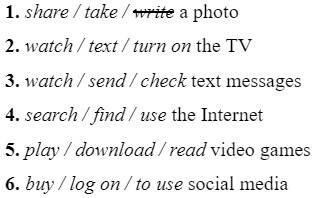Giải SGK Unit 7. Communication Explore New Worlds
Giải SGK Unit 7 Explore New Worlds
Vocabulary (Từ vựng)
A. In groups, read the information about teenagers in the US. Which facts do you think are surprising? Not surprising?
(Thực hành theo nhóm, đọc thông tin về thanh thiếu niên ở Mỹ. Bạn nghĩ sự thật nào đáng ngạc nhiên? Cái nào không đáng ngạc nhiên?)
 |
How Teenagers Use Technology in the US 72% look at their smartphone as soon as they wake up. 85% share photos on social media. 100% who have a smartphone write text messages, making it the most popular feature. 78% use Internet search engines to help with school work. 41% send their teachers emails. 45% use the Internet almost all the time. 90% play video games on a computer or a game console. 61% watch TV shows on the Internet, not on a traditional TV. |
C. Below is the contact information of some famous places. Take turns reading each of them aloud in pairs.
(Dưới đây là thông tin liên lạc của một số địa điểm nổi tiếng. Lần lượt đọc to từng câu theo cặp.)
1. 125 Hai Bà Trưng, District 1, Hồ Chí Minh City, Việt Nam; Tel. 028 392 472 47; http://hcmpost.vn; email: cskh@vnpost.vn
2. 1600 Pennsylvania Ave. NW, Washington DC, 20500, US; Tel. 1 202 456 1111; www.whitehouse.gov; email: comments@whitehouse.gov
3. 5 Avenue Anatole France, 75007, Paris, France; Tel. 33 08 92 70 12 39; www.tour-eiffel.fr
Grammar: Sensory Verbs (See Grammar Reference pp. 154-155)
(Ngữ pháp: Động từ chỉ giác quan (Xem Tài liệu Ngữ pháp trang 154-155)
B. Complete the table with these words.
(Hoàn thành bảng với những từ sau.)

|
The Five Senses (Năm Loại Giác Quan) |
Parts of the Body (Các bộ phận của Cơ thể) |
Sensory Verbs (Các động từ chỉ Giác Quan) |
|
sight (thị giác) |
eyes (mắt) |
5. __________________________ |
|
hearing (thính giác) |
3. __________________________ |
sound (nghe có vẻ) |
| 1. __________________________ |
mouth and tongue (miệng và lưỡi) |
taste (có vị) |
|
smell (khứu giác) |
4. __________________________ | 6. __________________________ |
| 2. __________________________ |
hands and fingers (bàn tay và ngón tay) |
7. __________________________ |
|
We use sensory verbs to describe the characteristics and qualities of people, animals, and things. (Chúng ta sử dụng các động từ chỉ giác quan để mô tả các đặc điểm và phẩm chất của con người, động vật và sự vật.) |
||
Reading (Đọc hiểu)
A. Does each type of human communication use the sense of sight, hearing, touch, or more than one?
(Mỗi kiểu giao tiếp của con người thì sử dụng các giác quan về thị giác, thính giác, xúc giác, hay nhiều hơn một loại phải không?)
| shaking hands | smiling | waving |
| writing | kissing | shaking your head |
| nodding your head | laughing | yelling |
D. Read the article. Match the words to the definitions.
(Đọc bài viết. Nối các từ với các định nghĩa.)
Do you speak “elephant”?
As humans, we communicate using the senses of sight, touch, and hearing. We send messages with body language, we greet friends with touch and we speak using words to show our emotions and ideas. Animals don't communicate in as many ways as humans – for example, they don't have language like we do – but many animals do also use the senses of sight, touch, and hearing. A good example of this is elephant communication.
Like humans, elephants understand each other by looking at each other's body language. To send a message, they use their whole body, or individually their heads, eyes, mouth, ears, trunk, tail, or feet. For example, elephants spread their ears to show anger. And while humans shake their heads to disagree elephants do this to show they are happy.
As with humans, touch is also very important between elephants. Just like a human mother holds her baby, a mother elephant regularly touches her young calf with her trunk. Elephants also show they are friendly when they touch other elephants. And when they want to have fun, they hold each other by the trunk and pull, like in this photo. Even if they can’t laugh like a human, elephants have a great sense of humor.
Elephants have very large ears, which means they can hear other elephants from as far as 2.5 miles away. Like humans, they can also copy sounds and make their own sounds that seem to communicate basic human words and phrases like, “Hello,” “I love you,” and “Let's go.”
calf (n): a young elephant
| a. | 1. body language | a. communication with the body |
| ____ | 2. to greet | b. feelings |
| ____ | 3. emotions | c. to do in a similar way |
| ____ | 4. sense of humor | d. to meet and say “hello” |
| ____ | 5. to copy | e. ability to have fun |
B. Which types of communication in A would you use in each situation? Fill in the Me column.
(Bạn sẽ sử dụng những kiểu giao tiếp nào từ bài A trong mỗi tình huống sau? Điền vào cột “Tôi”.)
|
You want to ... (Bạn muốn ... ) |
Me (Tôi) |
My partner (Bạn bên cạnh) |
|
1. send a photo to your grandparents. (gửi một bức ảnh cho ông bà của bạn.) |
||
|
2. apply for a scholarship. (xin học bổng.) |
||
|
3. keep in touch with friends from Brazil. (giữ liên lạc với bạn bè từ Brazil.) |
||
|
4. send an assignment to your teacher. (gửi bài tập cho giáo viên.) |
||
|
5. invite a friend out tonight. (mời một người bạn đi chơi tối nay.) |
Writing (Viết)
D. Read the information below. Then discuss in pairs if you would use formal or informal writing for each situation in B.
(Đọc thông tin bên dưới. Sau đó, thảo luận theo cặp nếu bạn sử dụng cách viết trang trọng hoặc thông thường cho mỗi tình huống trong bài B.)
|
WRITING SKILL: Formal and Informal Writing (Kĩ năng viết: Văn phong Trang trọng và Thông thường) |
||
|
Letters and emails are classified into 2 styles: formal and informal. The tone of your letter or email depends on who you are writing to and how well you know them. (Thư và email được phân thành 2 kiểu: trang trọng và thông thường. Giọng điệu của bức thư hoặc email của bạn phụ thuộc vào việc bạn đang viết thư cho ai và mức độ hiểu biết của bạn về họ.) |
||
|
Formal Writing (Văn phong Trang trọng) |
Informal Writing (Văn phong Thông thường) |
|
|
When to use (Thời điểm sử dụng) |
- writing to people we don't know (e.g., an employer) (viết thư cho những người mà chúng ta không biết (ví dụ: nhà tuyển dụng) - in business and professional situations (trong các tình huống kinh doanh và công việc) |
- writing to people we know well (eg., our friends, our family members) (viết thư cho những người mà chúng ta biết rõ (ví dụ: bạn bè, các thành viên gia đình) - in personal situations (trong các tình huống cá nhân) |
|
How to write (Viết như thế nào) |
- using full sentences and special expressions (sử dụng các câu đầy đủ và cách diễn tả đặc biệt)
Dear Mr. Smith, I am writing to apply for the scholarship of...., Please see my attached high school transcription. (Thầy Smith thân mến, em viết thư này để nộp đơn xin học bổng của ...., Vui lòng xem bảng điểm trung học được đính kèm của em.)
Dear Sir/Madam, I would like to inform you that ... Yours faithfully,) (Thưa ông / bà, Tôi xin thông báo với rằng ... Trân trọng,)
|
- using shorter sentences and contracted forms (sử dụng các câu ngắn hơn và cách viết ngắn gọn) - leaving words out at times (đôi khi bỏ qua vài từ)
Hi! I'm having a party. Want to come? (Xin chào! Mình đang tổ chức một buổi tiệc. Bạn có muốn tham gia không?) Hi guys, (Chào các cậu,) Let me tell you about... (Hãy để tôi kể cho bạn nghe về ...) Love, (Yêu quý,) |
E. In pairs, look at the three messages and number them from 1 to 3 (1 = most formal, 3 = least formal). Underline words and phrases that help you decide.
(Làm việc theo cặp, hãy xem ba tin nhắn này và đánh số chúng từ 1 đến 3 (1 = trang trọng nhất, 3 = ít trang trọng nhất). Gạch chân những từ và cụm từ sẽ giúp bạn quyết định các con số.)
|
Hi Chen, I'm having a party. It's my 18 birthday and my family and friends are meeting at a theme park. It’d be great to see you. The invitation is attached with the time, date, and address. Hope you can come! Best, Paula |
|
Dear Miss Jones: I am writing to request information about art courses at your college. I am a student in Argentina and I would like to study art in your country. Also, could you please send me information about accommodation and prices? Best regards, Paula Fratelli |
| Hey! I'm at the theme park. Where r u? |











